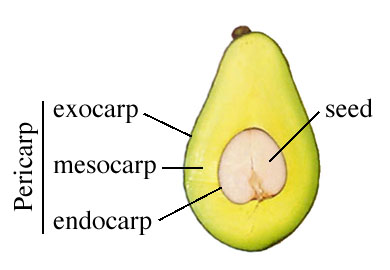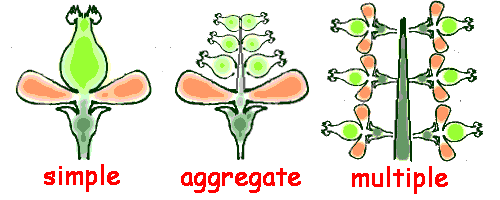Everybody likes fruits! Fruits are a characteristic of flowering plants. Once pollination and fertilization occur, the ovary of the plant becomes the fruit and the ovules become the seeds. They can be fleshy or dry. Let’s learn more about them.
The main purpose of fruits is that they protect the seeds during development. Since they are often colourful and emanate a delectable odour, they help in attracting birds and other animals to eat seeds. This way the seeds get dispersed to other areas for generating new plants.
Suggested Videos
Structure of a fruit
The fruit primarily contains two parts: the pericarp and the seed. The pericarp layer is actually the outer wall of the ovary from which the fruit developed. The pericarp has three layers:

Source: Google
- Exocarp or Epicarp: This is the outermost layer of the pericarp that forms the skin.
- Mesocarp: It is the thick, fleshy and juicy middle layer of the pericarp.
- Endocarp: It is the innermost layer of the fruit which often develops into the pith.
Classification of Fruits
On basis of the number of ovaries and the number of flowers involved in their formation, fruits are broadly classified into three categories:
- Simple Fruits
- Aggregate Fruits
- Multiple Fruits

Source: Backyard Nature(google)
Simple Fruits
- These fruits develop from a single ovary of one or more carpels.
- These fruits are further divided into Dry fruits and Fleshy fruits depending upon pericarp.
Dry Fruits
In these fruits, the pericarp is not succulent and the pericarp becomes dry one the fruits mature. Dry fruits are of two types: Dehiscent and Indehiscent.
a. Dehiscent fruits: These fruits dehisce or split open when they mature. Types of dehiscent dry fruits are:

Source: Google
- Follicle- is a dry dehiscent fruit which arises from a single carpal and on maturity splits only along one suture. E.g. Larkspur
- Legume- is a dry dehiscent fruit which arises from a single carpal and on maturity splits along its dorsal and ventral sutures. E.g. Pea
- Capsule- made up of multiple carpals and splits in four ways. E.g Eucalyptus
- Silique- is made up of two carpals that split on maturity. E. g Mustard plant
b. Indehiscent fruits: These fruits do not split open on maturity. Types of indehiscent dry fruits are:

Source: Google
- Akene- where the only seed is attached to the fruit at one point only. E.g. sunflower
- Caryopsis- where the only seed is attached to the fruit at all possible points. E.g. Maize
- Samara- is a one or two seeded which has seeds with wing-like structures. E.g.Maple
- Schizocarp- is made up of multiple carpals which separate on maturity to form multiple indehiscent fruits. E.g. Dill
- Nut- has thick pericarps and is a one-seeded fruit formed from a compound ovary. It is hard in texture. E.g Chestnuts
Fleshy Fruits
In these fruits, the fruit wall or pericarp is thick and fleshy. They are of the following types:

Source: Google
- Berry is made up of one or more carpals and contains one or more seeds. The pericarp is soft, fleshy and juicy. E.g Banana, grapes
- Drupe is derived from a single carpel and containing one seed. Exocarp is present as a thin skin, the mesocarp is fleshy and the endocarp becomes stony hard. E.g Mango
- Pome (accessory fruit) is an accessory fleshy fruit formed by a group of carpels that are firmly united with each other and surrounded by and united to the receptacle. E.g Apple
Aggregate Fruits
These fruits develop from multiple ovaries but of the same flower. So, an aggregate fruit consists of a collection of simple fruits called as fruitlets. E.g Blackberries, strawberries.
Multiple Fruits
They are formed by all the flowers of an inflorescence which together result in a single big fruit. Multiple fruits are called false or composite fruits. E.g Mulberries, pineapple.
Solved Example for You
Q: Which of the following types of fruit has seeds with wing-like structures?
(a) Akene (b) Capsule
(c) Samara (d) Caryopsis
Sol. (c) Samara
Samara is a simple dry indehiscent which is made up of one or two seeds which have a wing-like structure.






Use the
competitive examination
The apps is very helpful, but in the registration there is no Nigeria phone code?
seems like a good app,but,there countries missing,there is no ZAMBIA There,alot of african countrys not there for registraction,…what do we do for like us to register whose country is not there